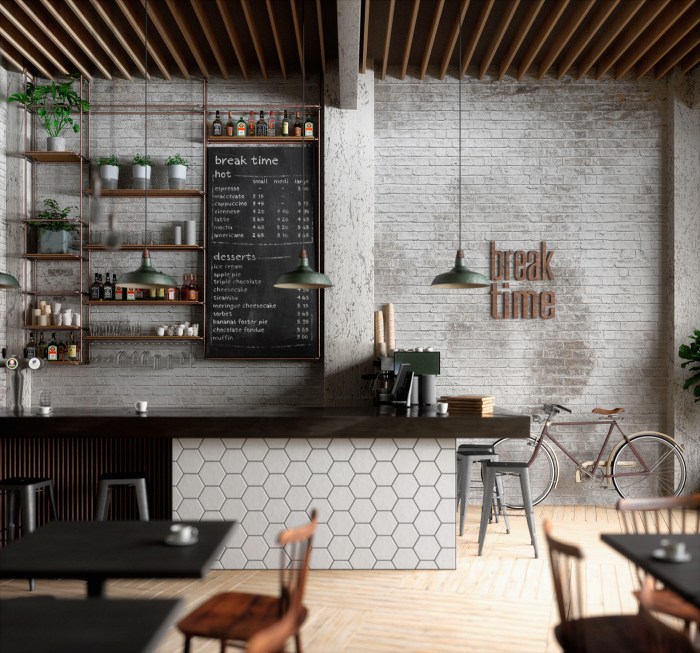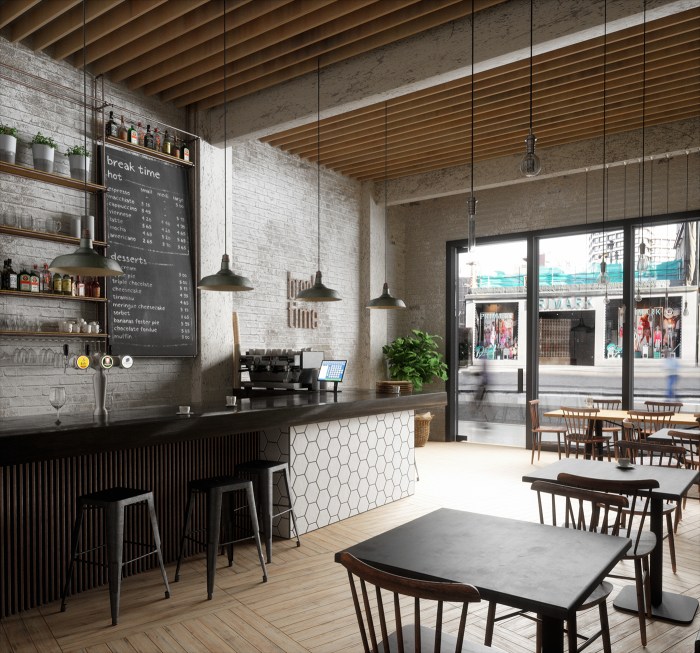Crafting the Perfect Coffee Shop Interior Design: A Guide to Creating a Welcoming Atmosphere

Exploring the realm of coffee shop interior design, this guide delves into the crucial aspects that shape the ambiance and customer experience. From essential elements to space planning and brand identity, discover how to curate a space that not only reflects your brand but also captivates customers.
Importance of Coffee Shop Interior Design
Interior design plays a crucial role in creating a welcoming atmosphere in a coffee shop. The layout, color scheme, furniture, and decor all contribute to the overall ambiance that customers experience when they walk in.
Impact on Customer Experience
The interior design of a coffee shop can greatly influence the customer experience. For example, cozy seating arrangements, warm lighting, and a calming color palette can make customers feel relaxed and comfortable, encouraging them to stay longer and make repeat visits.
On the other hand, a poorly designed space with uncomfortable seating, harsh lighting, and cluttered decor can drive customers away.
Examples of Successful Designs
Some successful coffee shop interior designs include minimalist Scandinavian-inspired spaces with clean lines and natural materials, vibrant and eclectic bohemian-style cafes with mismatched furniture and colorful artwork, and industrial-chic coffee shops with exposed brick walls and metal accents. These designs not only attract customers but also create a sense of loyalty and attachment to the coffee shop, turning it into a favorite spot for regulars.
Elements of Coffee Shop Interior Design
When designing the interior of a coffee shop, several elements play a crucial role in creating an inviting and cohesive space for customers to enjoy their coffee. These elements include lighting, furniture, color scheme, and layout.
Lighting
Proper lighting is essential in setting the mood and ambiance of a coffee shop. Consider using a mix of natural light, overhead lighting, and accent lighting to create a warm and welcoming atmosphere.
Furniture
The choice of furniture can greatly impact the comfort and style of a coffee shop. Opt for comfortable seating options like plush sofas, armchairs, and bar stools to accommodate different preferences and needs of customers.
Color Scheme
The color scheme of a coffee shop can influence the overall feel of the space. Neutral tones like white, beige, and grey can create a clean and modern look, while warmer tones like brown, orange, and red can evoke a cozy and inviting atmosphere.
Layout
The layout of a coffee shop should be designed to optimize flow and functionality. Consider factors like seating arrangements, traffic flow, and designated areas for ordering, pickup, and seating to ensure a smooth and enjoyable experience for customers.
Interior Design Styles
There are various interior design styles that can be suitable for coffee shops, such as industrial, minimalist, and cozy. Industrial style often features exposed brick walls, metal accents, and raw materials, while minimalist style focuses on simplicity and clean lines.
Cozy style incorporates soft textures, warm colors, and comfortable seating to create a homely feel.
Aligning with Brand Identity
When choosing elements for coffee shop interior design, it's important to consider how they align with the brand identity. The design should reflect the values, personality, and target audience of the coffee shop to create a cohesive and authentic experience for customers.
Space Planning and Layout

Effective space planning and layout are crucial aspects of coffee shop interior design, impacting both the functionality and overall customer experience of the space.
Importance of Efficient Space Utilization
Efficient space utilization in a coffee shop is essential for maximizing seating capacity, optimizing workflow for staff, and creating a comfortable environment for customers. By carefully planning the layout, you can ensure that every square foot is utilized effectively, leading to increased revenue and customer satisfaction.
Impact of Layout on Customer Flow and Experience
The layout of a coffee shop directly affects customer flow and overall experience. A well-thought-out layout can guide customers seamlessly from the entrance to the counter and then to their chosen seating area. It can also create different zones for socializing, working, or relaxation, catering to the diverse needs and preferences of customers.
Tips for Optimizing Seating Arrangements
- Create a variety of seating options, including communal tables, cozy nooks, and bar seating, to accommodate different customer preferences.
- Consider the traffic flow and ensure that there are clear pathways for customers and staff to move around comfortably.
- Use versatile furniture that can be easily rearranged to accommodate both small and large groups.
- Pay attention to lighting, acoustics, and decor to enhance the ambiance of each seating area and create distinct atmospheres within the coffee shop.
Lighting and Ambiance

Creating the right ambiance in a coffee shop is crucial for providing a welcoming and comfortable environment for customers. Lighting plays a significant role in setting the mood and highlighting key areas within the space.
Significance of Lighting
- Proper lighting can enhance the overall aesthetic appeal of the coffee shop and create a cozy atmosphere.
- Lighting can influence customer behavior and emotions, ultimately impacting their overall experience.
- Well-planned lighting can help guide customers through the space and draw attention to specific features or products.
Techniques to Enhance Ambiance
- Use a mix of ambient, task, and accent lighting to create layers and depth in the space.
- Adjust the intensity of light fixtures to control the mood - dimmer lights for a relaxed vibe and brighter lights for a more energetic feel.
- Highlight key areas such as the coffee bar, seating areas, or artwork with focused lighting to draw attention and create focal points.
Natural vs. Artificial Lighting
- Balance natural light from windows with artificial lighting to create a comfortable environment throughout the day and evening.
- Utilize natural light during the day to reduce energy costs and create a more inviting atmosphere.
- Supplement natural light with artificial fixtures in darker areas or during nighttime to maintain a consistent ambiance.
Incorporating Brand Identity
Reflecting a brand's identity through interior design is crucial for creating a cohesive and memorable experience for customers. By integrating branding elements into the design of a coffee shop, you can effectively communicate the values, personality, and unique characteristics of the brand to customers.
Consistency between brand messaging and interior design helps in reinforcing the brand image and building brand recognition among customers.
Examples of Branding Elements Integration
- Colors: Incorporating the brand's color palette into the interior design through wall paint, furniture, decor, and branding materials.
- Logo and Graphics: Displaying the brand logo prominently and integrating branded graphics into the design elements like signage, menus, and wall art.
- Messaging: Using brand slogans, quotes, or mission statements as part of the decor to reinforce brand messaging and values.
- Materials and Texture: Choosing materials and textures that align with the brand's identity, whether it's modern, rustic, minimalist, or luxurious.
Importance of Consistency
Maintaining consistency between brand messaging and interior design is essential for creating a unified brand experience. When customers walk into a coffee shop, they should immediately recognize and connect with the brand through the design elements. Consistency builds trust and credibility, enhances brand recall, and ensures that the brand is perceived as authentic and reliable by customers.
Furniture and Decor
When it comes to coffee shop interior design, furniture and decor play a crucial role in creating a welcoming and functional space for customers. The right furniture pieces and decor elements can enhance the overall ambiance and contribute to the branding of the coffee shop.
Role of Furniture
Furniture in a coffee shop serves both functional and aesthetic purposes. Comfortable seating arrangements can encourage customers to stay longer and enjoy their coffee, while also complementing the design theme of the space.
Selecting Complementary Furniture
- Choose furniture that aligns with the overall design theme and brand identity of the coffee shop.
- Consider the comfort and durability of the furniture, especially for high-traffic areas.
- Mix and match different types of seating options to cater to various customer preferences.
- Opt for furniture pieces that are easy to clean and maintain for efficiency.
Significance of Decor Elements
Decor elements like artwork, plants, and decorative items contribute to the atmosphere of the coffee shop and add a personal touch to the space. These elements can help create a unique and memorable experience for customers, setting the coffee shop apart from the competition.
Sustainability in Interior Design
As the awareness of environmental issues continues to grow, the trend of sustainable design practices in coffee shops is becoming increasingly popular. This shift towards eco-friendly interior design choices is not only beneficial for the planet but also for the overall aesthetic and appeal of the space.
Examples of Eco-Friendly Materials and Design Choices
- Utilizing reclaimed wood for furniture and decor
- Choosing energy-efficient lighting options such as LED bulbs
- Opting for low VOC paints and finishes
- Incorporating recycled materials into the design scheme
- Installing water-saving fixtures in restrooms and kitchen areas
Benefits of Incorporating Sustainability
- Reduction in environmental impact and carbon footprint
- Enhancement of brand image and reputation as a socially responsible business
- Cost savings through energy efficiency and waste reduction
- Creating a healthy and eco-friendly environment for both customers and employees
- Appealing to eco-conscious consumers and attracting a loyal customer base
Closing Notes
In conclusion, mastering the art of coffee shop interior design is more than just aesthetics; it's about crafting an immersive experience that resonates with your customers. By blending elements like lighting, furniture, and brand identity, you can create a space that fosters loyalty and leaves a lasting impression.
Essential FAQs
How does interior design impact customer loyalty?
Interior design plays a crucial role in creating a welcoming atmosphere that encourages customers to return, fostering loyalty over time.
What are some examples of successful coffee shop interior designs?
Successful coffee shop designs often focus on elements like cozy seating arrangements, warm lighting, and unique decor that align with the brand's identity.
Why is efficient space planning important in a coffee shop?
Efficient space planning ensures optimal customer flow, maximizes seating capacity, and enhances the overall experience for patrons.
How can lighting be used to enhance the mood in a coffee shop?
Strategic use of lighting can create different moods, such as cozy or vibrant, and highlight key areas like the counter or seating zones.
What role does furniture play in coffee shop interior design?
Furniture not only provides functionality but also contributes to the overall theme and comfort of the space, influencing customer satisfaction.

